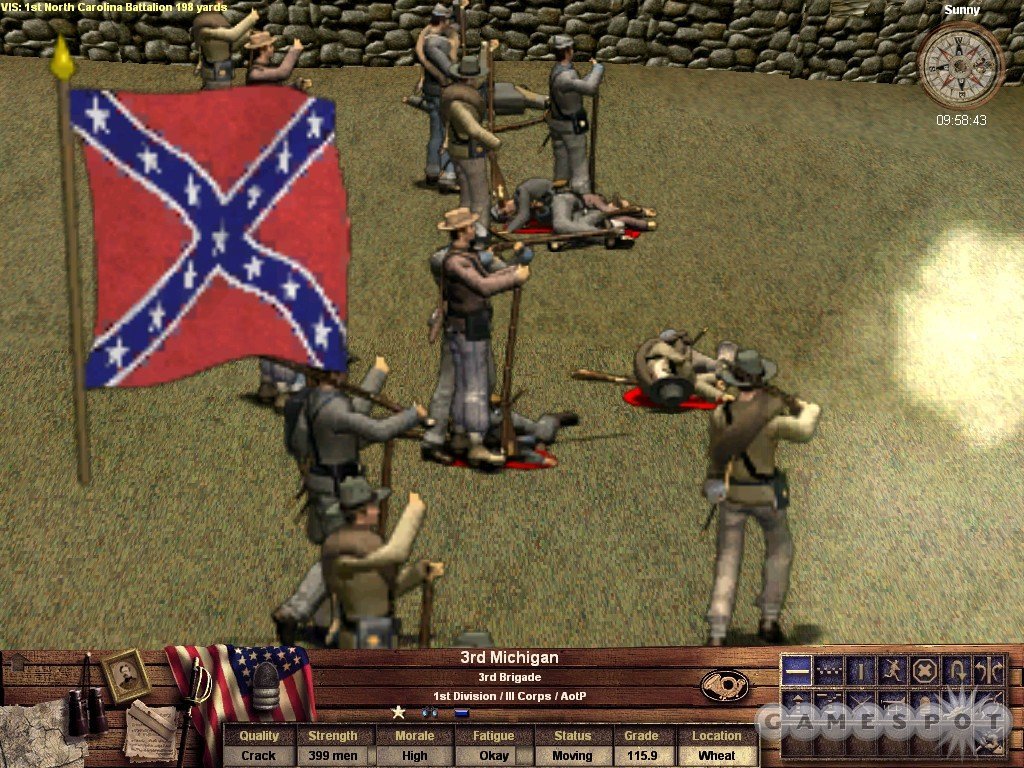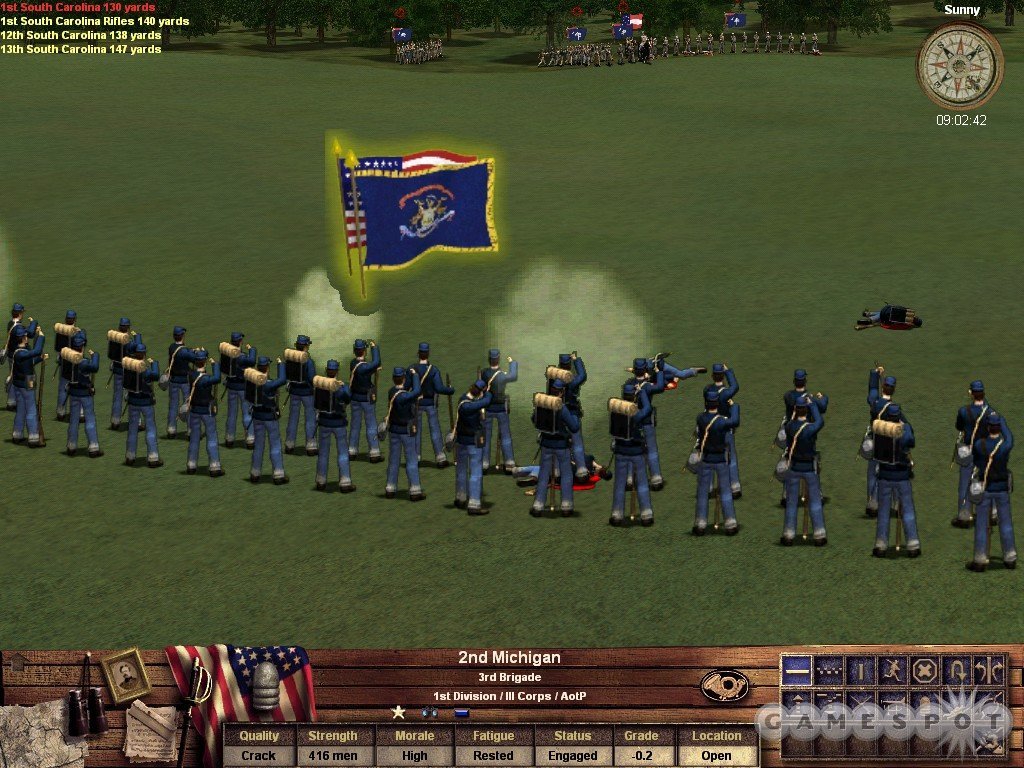Self-professed hole-in-the-wall game developer MadMinute Games made quite a splash at the start of 2005 with Take Command: The Battle of Bull Run. Although the company may be a tiny outfit with just two core designers in Adam Bryant and Norb Timpko, both the game itself and the War3D engine that powered it got raves from hardcore wargamers and Civil War buffs. That success apparently wasn't a fluke, either, since the recently released sequel, Take Command: Second Manassas, does an equally good job at depicting another key battle in the war between the states. Although everything will feel a touch "been there, done that" to those who played the original game, hardcore wargames are rarely this approachable and enjoyable. Casual strategy gamers might find that MadMinute has too much of the real Civil War in its Civil War game, as the design has more in common with an old Avalon Hill board game than the typical strategy computer game, but you can't quibble with either the playability or the historical accuracy.

All 18 formal scenarios, plus those whipped up with the open battles sandbox mode (there is no multiplayer), focus on recreating how Confederate general Robert E. Lee and his Northern Virginia Army broke out of Richmond in August of 1862 and pushed the Union to the brink of defeat at Second Manassas (also called the Second Battle of Bull Run). Even though these engagements play out during a single month, sides are regularly swapped and battle scenarios from offensive to defensive to a blend of the two are depicted, so you get a broad view of the character of the entire Civil War. One moment you're brigadier general Jubal A. Early propping up Confederate artillery in "Holding the Center," and the next you're seizing Groveton as federal brigadier General John P. Hatch in "Push Him Like the Devil." Historical accuracy appears to be dead on, at least if we can recall what we read in those Shelby Foote books many years ago. There are a handful of speculative scenarios, but they don't take the "what if?" formula beyond the boundaries of the credible.
Combat feels authentic beyond the basics of ensuring that regiments and commanders remain true to the textbooks. Positioning is crucial. You need to get your artillery into the right position and place your infantry in the ideal spot to both gain a good firing height and an ideal location for an enemy-breaking bayonet charge. This isn't particularly easy. Maps are sprawling affairs (which get the job done nicely despite being pretty dated, with blurry troops and choppy animations) filled with battle-affecting physical features such as forests, roads, walls, and farmhouses.
Keeping tight rein on your men is also difficult. While the interface and graphical engine give you excellent command of camera views and units, there are a lot of troops to manage. Scale is stepped down from reality, with columns of a couple of dozen soldiers representing brigades, so you don't have to deal with battles on par with the confusing majesty of something such as Rome: Total War. But since there are still swarms of little red and blue guys out there to manage when the guns go off, the proceedings can get fairly hectic fairly fast. The bigger battles during the final two days of the Manassas campaign are absolutely huge, albeit still manageable.
Also, Command & Conquer-style maneuvering didn't happen in Virginia in 1862, and it doesn't happen here. Keying battle strategy on precise maneuvering and timing is a recipe for disaster because soldiers simply don't move that smartly or that quickly. You have to adopt a general plan based on a general strategy no more specific than, say, fending off Johnny Reb' by firing from the protection afforded by a stone wall and not pile all your hopes on clockwork unit positioning possible in other real-time strategy games. This nicely brings to life the chaos of the average Civil War battle, but it also leads to a certain level of frustration in gamers used to the pinpoint movement of armies across battlefields.
Battles are much more orderly than you would think, though, largely thanks to immaculate artificial intelligence. Brigade commanders do a solid job of issuing orders in your stead when the shooting starts, so you don't need to concern yourself with micromanagement. Forget to put a brigade into a proper firing line when moving into firing position--which is almost inevitable in larger battles, as you tend to be dealing out orders to at least a half-dozen brigades at any given time--and the commander takes over and does it for you. He also shifts the line into ideal firing position, swings in around to target a new enemy column if the first is dispersed or destroyed, and is quick to order his men to respond if ambushed. Essentially, the urge for self-preservation kicks in smartly whenever you drop the ball. Control freaks might not appreciate this, as it can fairly be said that aspects of the game run on autopilot. But this does add to the authenticity of being involved in a real battle, with real human commanders taking and interpreting your orders.
Pace is also an acquired taste, with slow battles that play out akin to the methodical, steady grind of a tabletop wargame. The smaller opening skirmishes take between 30 and 45 minutes to finish, while larger climactic battles that in real life sent the Union army fleeing across the Potomac can take a good three hours. Major engagements usually begin with you settling in to listen to a good five minutes of boom-boom-boom artillery barrages (battle sound effects are well done, at least, if a bit repetitive and almost totally devoid of human cries and screams that would have added emotion to victories and defeats) while brigades lumber into harm's way. And then you need to wait a considerable while longer for infantry columns to get into firing range, as the developers seem to have a fetish for starting troops as far from the shooting as is possible.

Fast-forwarding is offered, although it isn't all that useful. It doesn't speed things up all that much and is unavailable outside of battle preambles, as it shuts off as soon as the first shot is fired. Again, the slowness is a lot like what it must have been for the real bluecoats and greycoats back in the 1860s. This sort of sluggishness can be a little on the tedious side in 2006, though, even while it builds tension and allows players plenty of time to consider strategies. (Maybe it provides too much time, actually, as it is hard to resist tweaking orders and rethinking entire battle plans while watching troops move into firing position.)
If you're a wargamer with an interest in the Civil War, you will love Take Command: Second Manassas. The only caveat is that the rigorous attention to historical detail makes for such a leisurely pace that casual gamers might be scared away. Then again, the casual crowd isn't apt to be interested in a hardcore Civil War reenactment sim in the first place, so MadMinute's target demographic isn't likely to care.